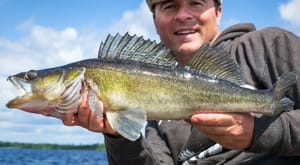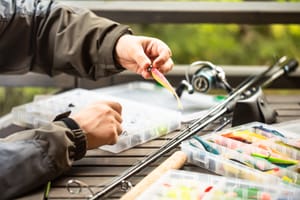Walleye fishing is both a science and an art, with anglers constantly seeking the edge that will make their day on the water both enjoyable and successful. One of the most debated topics is the best color for walleye jig heads. This article dives into the nuances of selecting the perfect hue to increase your chances of a bountiful catch.
Key Takeaways:
- Understanding the importance of jig head color selection for walleye fishing.
- Insights into how water conditions influence the best color choice for walleye jig heads.
- Practical tips for experimenting with different colors to find the most effective option for your fishing environment.
The Science Behind Color Selection
When it comes to choosing the best color for walleye jig heads, it's essential to understand the science of how walleye perceive color. Walleye vision is tuned to detect certain colors better than others, especially in low-light conditions. This means that the color of your jig head can significantly impact your success rate.
Walleye are known for their excellent night vision, which allows them to see well in murky or dark waters. They are particularly sensitive to the blue and green spectrum, making these colors a good starting point. However, the clarity and depth of the water, as well as the amount of light available, play a crucial role in determining which color will stand out best to these predatory fish.
Water Clarity and Color Choice
The clarity of the water is a critical factor when selecting the best color for walleye jig heads. In clear water, natural and subtle colors tend to work best as they mimic the appearance of real baitfish. Silver, gray, and white can be particularly effective as they reflect light and create a lifelike flash that can attract walleye from a distance.
Conversely, in stained or muddy waters, brighter and more vibrant colors are often the go-to choice. Chartreuse, orange, and pink can provide the necessary contrast to stand out in these conditions. The goal is to make your jig head visible to walleye despite the reduced visibility.
Light Conditions and Lure Visibility
Light conditions are another crucial aspect to consider when choosing jig head colors. During dawn and dusk, when walleye are most active, colors that provide high visibility in low light can be particularly effective. Glow-in-the-dark or fluorescent colors can be excellent choices during these times, as they can be seen from greater distances.
In bright, midday conditions, walleye may be deeper and less active, but they can still be enticed with the right color. Metallic colors that mimic the natural flash of baitfish, such as gold or bronze, can be effective in reflecting sunlight and catching the attention of deeper-dwelling walleye.
Seasonal Color Strategies
Seasonal changes can also influence the best color for walleye jig heads. In the spring, when walleye are spawning, they may be more aggressive and attracted to brighter colors. During this time, reds and oranges can be particularly effective as they can trigger a predatory response.
In the fall, as the water cools and vegetation begins to die off, walleye may respond better to darker colors that blend in with the changing environment. Browns, greens, and blacks can be good choices during this time, as they can mimic the natural prey that walleye are targeting.
Experimenting with Color Combinations
While there are general guidelines for selecting the best color for walleye jig heads, the truth is that there is no one-size-fits-all answer. Water conditions can change rapidly, and what works in one lake or river may not work in another. This is why experimenting with a variety of colors and combinations is essential.
Anglers should be prepared to switch colors throughout the day as conditions change. Carrying a selection of jig heads in various colors will allow you to adapt quickly and find the combination that works best. Paying attention to the behavior of the walleye and noting which colors are most effective will help refine your selection over time.
Summary
Choosing the best color for walleye jig heads is a nuanced process that requires consideration of several environmental factors. By understanding how walleye perceive color, and how water clarity and light conditions affect visibility, anglers can make informed decisions that increase their chances of success. Remember to experiment with different colors and take note of what works best in your specific fishing conditions. Dive deeper into successful walleye fishing by checking out our selection of the 7 BEST Walleye Jig Heads For 2024 – essential additions to any angler's tacklebox!
FAQ Section
Does the color of the jig head really make a difference when fishing for walleye?
Yes, the color of the jig head can significantly impact your success rate when fishing for walleye. Walleye vision is adapted to detect certain colors better, especially in low-light conditions, so choosing the right color can make your lure more visible and attractive to them.
What color jig head is best for fishing in muddy water?
In muddy or stained water, bright and vibrant colors like chartreuse, orange, and pink are often the best choices. These colors provide the necessary contrast to stand out and attract walleye in reduced visibility conditions.
How often should I change the color of my jig head when fishing for walleye?
You should be prepared to change the color of your jig head as water and light conditions change throughout the day. It's also a good idea to switch colors if you're not getting bites, as walleye preferences can vary. Keeping a variety of colors on hand and experimenting will help you find the most effective option.



